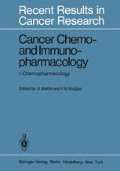Abstract
N-Phosphonacetyl-l-aspartic acid (PALA) is a new synthetic antimetabolite which inhibits de novo pyrimidine biosynthesis. Its significant activity against Lewis lung carcinoma, B16 melanoma, and glioma 26 suggested that it might be useful in the treatment of human solid tumors. Phase I trials revealed that dose-limiting toxicity included skin reactions, diarrhea, and stomatitis. Pharmacologic studies demonstrated rapid renal excretion of more than 70% of the unmetabolized drug in 24 h. Peak plasma levels correlated with dose of PALA administered. Partial responses to PALA were seen in one patient with melanoma, one with chondrosarcoma, and one with colon carcinoma. The potential for PALA’s use in combination chemotherapy, particularly with 5-fluorouracil, is discussed.
Access this chapter
Tax calculation will be finalised at checkout
Purchases are for personal use only
Preview
Unable to display preview. Download preview PDF.
References
Chadwick M, Silveira DM, MacGregor JA, Branfman AR, Liss RH, Yesair DW (1978) Physiological disposition of PALA in several species. Proc Am Assoc Cancer Res 19:182
Collins KD, Stark GR (1971) Aspartate transcarbamylase, interaction with the transition state analogue N-(phosphonacetyl)-L-aspartate. J Biol Chem 246:6599–6605
Erlichman C, Strong J, Wiernik P, Edwards L, Cohen M, Levine A, Hubbard S, Chabner B (1979) Phase I trial of PALA (N-phosphonacetyl-L-aspartate). Proc Am Soc Clin Oncol 20:314
Ervin TJ, Blum RH, Canellos GP (1979) JV-Phosphonacetyl-L-aspartate (PALA), phase I trial. Proc Am Assoc Cancer Res 20:200
Gralla RJ, Casper ES, Golbey RB, Young CW (1979) Phase I and preliminary phase II studies with N-(phosphonacetyl)-L-aspartic acid (PALA). Proc Am Assoc Cancer Res 20:115
Jayaram HN, Cooney DA, Vistica DT, Kariya S, Johnson RK (1979) Mechanisms of sensitivity or resistance of murine tumors to N-(phosphonacetyl)-L-aspartate. Cancer Treat Rep 63:1291
Johnson RK (1977) Reversal of toxicity and antitumor activity of iV-(phosphonacetyl)-L-as- partate by uridine or carbamyl-DL-aspartate in vivo. Biochem Pharmacol 26:81–84
Johnson RK, Inouye T, Goldin A, Stark GR (1976) Antitumor activity of iV-(phosphon- acetyl)-L-aspartic acid, a transition state inhibitor of aspartate transcarbamylase. Cancer Res 36:2720–2725
Kempe TD, Swyryd EA, Bruist M, Stark GR (1976) Stable mutants of mammalian cells that overproduce the first three enzymes of pyrimidine nucleotide biosynthesis. Cell 9:541–550
Kensler TW, Jayaram HN, Cooney DA, Petrucci PE (1979) Inhibition of L-aspartate transcarbamylase (ATCase) in human leucocytes by N-(phosphonacetyl)-L-aspartic acid (PALA): Use of peripheral white blood cells as enzymic indicators. Proc Am Assoc Cancer Res 20:243
Levine RL, Hoogenraad NJ, Kretchmer N (1974) A review: Biological and clinical aspects of pyrimidine metabolism. Pediatrics 8:724–734
Moore EC, Friedman J, Valdievieso M, Marti JR, Russ J, Loo TL (1979) N-(Phos- phonacetyl)-L-aspartate (PALA) concentration and aspartate carbamoyl-transferase (ATCase) activity in biopsy specimens of patients treated with PALA. Proc Am Assoc Cancer Res 20:221
Nayak R, Martin D, Stolfi R, Furth J, Spiegelman S (1978) Pyrimidine nucleosides enhance the anti-cancer activity of FU and augment its incorporation into nuclear RNA. Proc Am Assoc Cancer Res 19: 63
Ohnuma T, Hart R, Roboz J, Andrejczuk A, Holland JF1979) Clinical and pharmacological studies with phosphonacetyl-L-aspartate (PALA). Proc Am Soc Clin Oncol 20:344
Tsuboi KK, Edmunds HN, Kwong LK (1977) Selective inhibition of pyrimidine biosynthesis and effect on proliferative growth of colonic cancer cells. Cancer Res 37:3080–3087
Valdivieso M, Moore EC, Loo TL, Bodey GP, Freireich EJ (1979) Phase I clinical study of N-(phosphonacetyl)-L-aspartate (PALA, NSC 224131). Proc Am Assoc Cancer Res 20:187
Editor information
Editors and Affiliations
Rights and permissions
Copyright information
© 1980 Springer-Verlag Berlin Heidelberg
About this chapter
Cite this chapter
Erlichman, C. (1980). An Overview of the Clinical Pharmacology of N-Phosphonacetyl-L-Aspartate (PALA), a New Antimetabolite. In: Mathé, G., Muggia, F.M. (eds) Cancer Chemo- and Immunopharmacology. Recent Results in Cancer Research, vol 74. Springer, Berlin, Heidelberg. https://doi.org/10.1007/978-3-642-81488-4_9
Download citation
DOI: https://doi.org/10.1007/978-3-642-81488-4_9
Publisher Name: Springer, Berlin, Heidelberg
Print ISBN: 978-3-642-81490-7
Online ISBN: 978-3-642-81488-4
eBook Packages: Springer Book Archive

